
I finally got around to buying a modern phone, upgrading my Galaxy SII to a Galaxy S6 Note Edge. With the upgrade in tech, I've finally started trying out some of the free-to-play mobile games that are flooding the market. I had already played SimCity Buildit on my previous phone, but its poor performance and bugs held me back from bothering with any other games on that old SII. But now that I have a new phone, I wanted to try the Star Trek-themed game Trexels.
Star Trek games are few and far between, and good ones are virtually unheard of. Probably my favorite Star Trek game ever was the Windows 98 4x-strategy game Birth of the Federation, which was basically just a Trek reskin of Microprose's Master of Orion II. It wasn't the most technically proficient of games, and the A.I. blatantly cheated, but it was a game that captured the essence of Star Trek by being primarily about exploring the galaxy and colonizing new worlds. Most Trek games are content to just be reskins of shooters or space combat games, which always feels out of place. So Birth of the Federation, despite its obvious flaws, has always stood out to me as a game that really felt like one of the most appropriate uses of the Star Trek license for a video game.
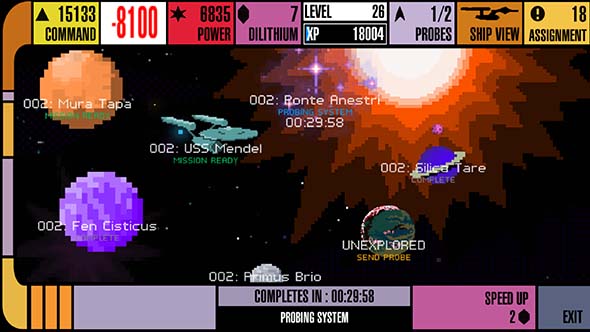
Finally, a Star Trek game that's about exploring space, rather than just shooting things!
And that brings us to Trexels, a free-to-play mobile game that is about exploring space while developing the skills of your ragtag crew and completing the construction of your ship. Sounds like a Star Trek-worthy premise. At least it isn't a first-person shooter. You start the game with a mostly-empty ship and handful of crew members. Your task is to build infrastructure in the ship to allow you to acquire new crew and harvest resources (including "command point", "research", "power", and "dilithium").
To boldly grind...
Resources are harvested by assigning crew to work the relevant rooms, and then you wait some period of real time for the crew to complete the assignment so you can collect the resource. You spend your accumulated resources to build new rooms in the ship, train your crew to increase their ability points, and attempt missions. Completing missions rewards you with experience and ... more resources? So it's kind of circular: you spend resources to attempt mission, and then are rewarded with some of the resources that you spent.
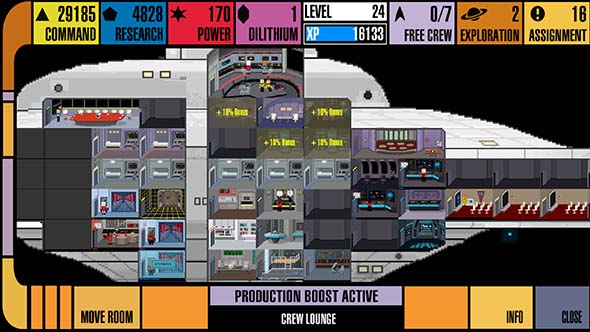
Your crew harvests resources from specific rooms, and other rooms unlock abilities and power-ups.
You also gain general experience, which doesn't really do much other than to unlock new expansion slots for rooms in your ship. Virtually everything you do gives you experience, so you level up fairly quickly. I always have way more available expansion slots than I can possibly use due to the slow rate in which you acquire resources. Once you get past the very first few missions and room-construction, the game really starts to turn into a slow, slogging grind... [More]
97535ad4-7e52-48fc-bff8-8d9b5c2f63d7|2|4.0
Tags:Star Trek, Trexels, YesGnome, xCube Games, construction management, exploration, space, crew, ship, TOS, social gaming, mobile gaming, mobile, iOS, android
NASA's New Horizons spacecraft set a major milestone for human space exploration earlier this week. Its approach of Pluto means that every solar body that is now - or ever has been - considered a "planet" has been visited by at least one NASA space probe. The probe was launched in January of 2006 (back when Pluto was still a "planet"), and it will continue out beyond Pluto and into the mysterious Kuiper Belt to continue its exploration of the solar system.
In the meantime, the probe has sent back months-worth of high-resolution images and scans for NASA scientists to study. The early results are already full of surprises.
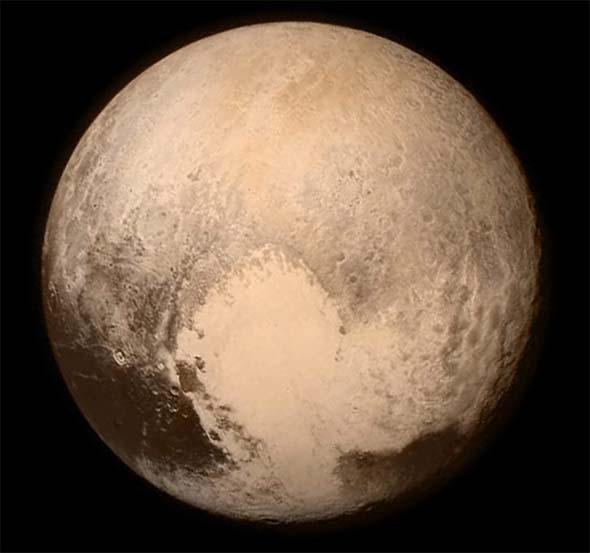
New Horizon's first, high-res photograph of Pluto (July 14, 2015).
Pluto - it turns out - is not the old, craggy, cratered world that many scientists expected it to be. In fact, it appears quite young, with tall, rocky mountains and nary a single impact crater. This is surprising considering the body's proximity to the Kuiper Belt, which contains numerous asteroids, and other small, rocky bodies left over from the formation of the solar system.
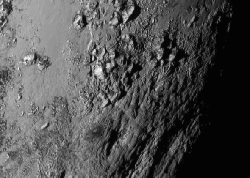
Large mountains were found on Pluto.
The probe also found possible evidence of frozen water. Frozen nitrogen and methane were expected, but early photographs suggest that frozen water may also make up a large portion of Pluto's crust. This is exciting for scientists because the presence of water (even in frozen ice form) is a possible indicator of life. There doesn't appear to be any liquid water (at least not yet), so the prospects for life are much better on Jupiter's moon Europa (which may have underground liquid oceans warmed by subterranean vents), or Saturn's moon Titan (which has a dense atmosphere and possible liquid surface water). But it at least adds Pluto to the list of possible targets of further study.
New Horizons was actually making discoveries long before it reached Pluto. In 2007, it captured video of a massive volcanic eruption on Jupiter's moon Io. It was a pretty spectacular sight to behold.

A five frame video of a massive volcanic plume on Jupiter's moon Io (taken in 2007).
As an interesting piece of trivia: the New Horizons craft also contains the cremated remains of Clyde Tombaugh, the man who first discovered Pluto in 1930. He had requested that his ashes be sent to space. Not only did NASA oblige, but they send his ashes to the very body that he became famous for discovering. He had died in 1997, and you'd be hard-pressed to come up with a more fitting interment for an astronomer.
More information about Pluto and the New Horizons mission can be found on NASA's official webpage at https://www.nasa.gov/mission_pages/newhorizons/main/index.html.

A history of the images of Pluto. [More]
f6f62fb4-6f44-4ad4-a4de-d1c9929d450e|1|5.0
Tags:Pluto, New Horizons, space, space probe, NASA, solar system, planet, dwarf planet, moon, water, Io, Clyde Tombaugh

Being someone who appreciates good science fiction and has an interest in real-life space exploration, it's easy for me to become intrigued with any game that promises to let me explore an alien world. Lifeless Planet promised to let me do just that, so it was a no-brainer Steam Summer Sale purchase for me last year, despite the mediocre critical reviews.
The basic premise of the game is that you play as a colonist sent to alien planet thought to be rich in life and habitable for humans. You wake up from cryo-sleep to find your ship has crash landed and your two crewmates are missing. Worse yet, the planet you crashed on seems to be a desolate wasteland devoid of life.
Are you even on the right planet? If so, where's all the life?
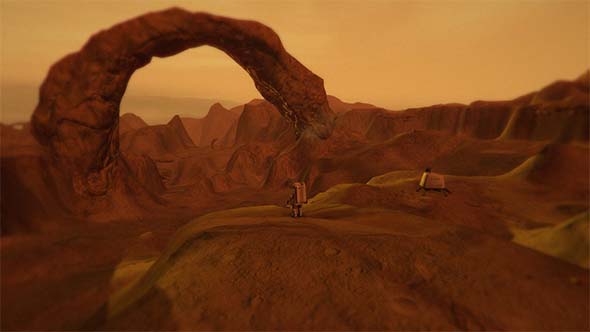
And we're off to find our missing crew-mates and figure out why the planet is lifeless.
From here, you set off to follow the tracks of your fellow crew mates in an attempt to find them and figure out where you are. Things get complicated very early on when you find a long-abandoned Soviet village. Wherever you happen to be, the Ruskies beat you to it!
But this just opens up even more questions: how did the Russians get here? And where did they all go? The mysteries behind these questions are supposed to be the driving force behind the game.
The bulk of the game, thus consists of wandering around the various alien landscapes in search of answers. This exploration requires a moderate amount of fairly trivial platforming, and you stop occasionally solve an elementary puzzle.
Platforming is mostly comfortable and works adequately. You have a malfunctioning jet pack that allows you a small boost to elevate you to higher platforms, jump longer gaps, or soften your fall. I had some occasional problems with the character sliding off of the geometry, and there were a couple areas late in the game that required multiple jumps without stopping that were difficult to control accurately. But other than that, the challenge of the platforming was minimal. The intended route is always obvious, so there was never any question about where I was supposed to go.
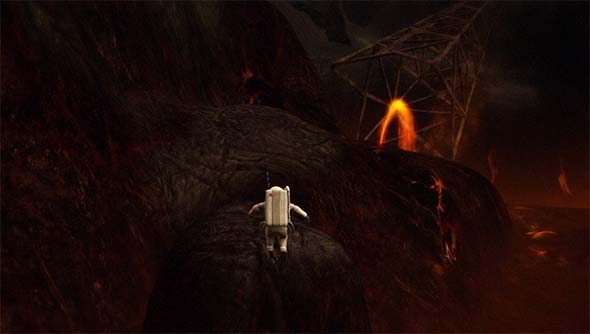
Your jet pack allows you to clear pitfalls and jump over large obstacles.
Puzzles aren't much more of a challenge. They are almost all environmental or physics puzzles that vary from "find the key" to "put the rock in the hole" to "push the boulders". There's nothing here that a grade-schooler couldn't figure out.
The rest of the game is just a steady walk along the linear paths ...
[More]
644391df-c7c0-4240-9d5b-33dfda1071c1|2|3.0
Tags:Lifeless Planet, Stage 2 Studios, Lace Mamba Global, Steam, indie gaming, science fiction, space, exploration, colonization, astronaut, platform, puzzle, adventure, allegory, Soviet Union, Russia, Cold War, portal, alien, plant, radiation, Achievement unlocked

I was finishing up my Civ V: Brave New World strategies this fall, and thought that I'd finally have some time to play other games besides Civilization. Firaxis and 2K, however, had other plans. Instead of being able to play other Steam games and getting back to my PS3, instead, I now have Civ in SPACE!
I guess I can't escape Civ so easily...
So is Beyond Earth going to hold my attention, keep me up till 3 in the morning playing "one more turn", and monopolize my PC gaming? Or will it be a short diversion before being shelved in favor of other games?
Table of Contents
Most of the gameplay mechanics of Beyond Earth are variations of equivalent mechanics in Civilization V, with more or less complexity. This makes the game very accessible and familiar for most Civ players, but it also means that Beyond Earth isn't really pushing any gameplay boundaries. Whereas Civ V's transition to a hex grid revolutionized the series, Beyond Earth just feels like more of the same.
Most of the added complexity works in the game's favor, but some mechanics have been simplified such that they almost feel pointless.
Beyond Earth's extraterrestrial setting does play a small factor in the gameplay and differentiates this game a bit from Civilization V. The most prominent displays of this are in the alien life forms and the terrain of the map. The inclusions of canyons as a geography characteristic is mostly superficial, as they function almost identically to mountains. The biggest change is the inclusion of toxic "miasma". Miasma tiles cause damage to units that end their turn on it, and trade units cannot pass through miasma at all.
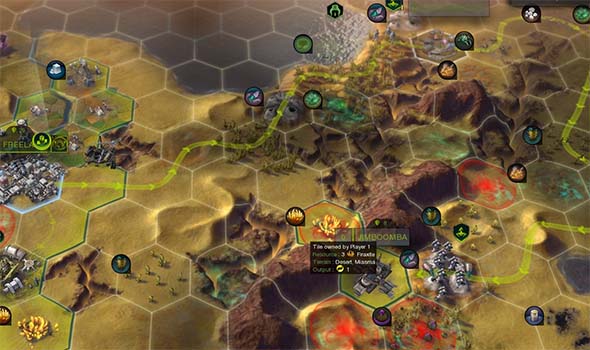
Miasma damages units and blocks trade routes until you unlock the ability to remove it or survive it.
This adds a satisfying challenge and sense of having to deal with a hostile alien environment.
This adds some challenge to the first half of the game, since miasma can force the player to explore and expand differently than they would in Civ V. Miasma can force your workers to have to avoid improving certain terrain, and may prevent explorers from accessing certain regions of the map or completing some expedition sites. It can also prevent your trade units from following direct routes between cities, which can cause them to follow winding paths far outside your inherent zone of control, making them harder to protect.
Contrary to the developers' claims prior to release, the aliens really are just reskins of Civ V's barbarians. They are counted as "enemy" units to every civilization and inflict zone of control automatically. They spawn randomly from nests that function identically to encampments, and even offer monetary rewards for entering the tile and destroying the nest. The only major difference is ... [More]
aed9db83-3047-4b4d-b015-5efe80732985|3|4.0
Tags:Sid Meier's Civilization, Civilization: Beyond Earth, review, science fiction, space, affinity, Firaxis, 2K Games, PC, Steam, strategy, grand strategy, turn-based strategy, alien, Civilization: Beyond Earth
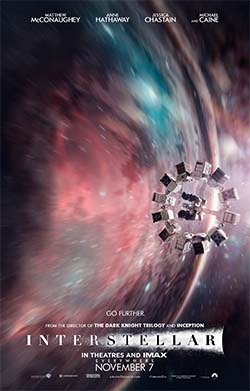
Interstellar is a rare hard sci-fi movie.
There has been a sad dearth of hard science fiction movies in recent memory. While comic book and alien invasion movies and the like have been proliferating (and some of them have been very good), there haven't been as many movies that have been willing to take science fiction subject matter seriously. The only mainstream releases that I can think of off the top of my head are District Nine, Inception, and Gravity, neither of which really wowed me. District Nine was alright, but I felt that its racism allegory fell flat since the aliens themselves considered the majority of their species to be mindless automatons. Inception was a fun ride, but nowhere near as clever or complicated as people made it out to be. And Gravity wasn't really "science fiction"; more like just "space drama" disaster porn.
That leaves the indie movie Moon and the surprisingly good Rise of the Planet of the Apes and Dawn of the Planet of the Apes as the only really good examples of high-brow science fiction that I can think of - and maybe Edge of Tomorrow can count as "medium-brow".
That's why I've been very excited about Christopher Nolan's new movie, Interstellar. It had all the trappings of a modern-day 2001: A Space Odyssey, which (confusing psychedelic ending aside - read the book!) is one of the best hard science fiction movies ever made. Interstellar definitely lived up to this expectation, but it's a much gloomier and more depressing epic than Arthur Clark and Stanley Kubrick's masterpiece.
The space travel plot is, in fact, almost identical to 2001. A crew must travel in hypersleep in an experimental spacecraft to investigate an anomaly around Saturn (the original 2001 book placed the monolith in orbit around Saturn, but it was changed to Jupiter for the film). The sleeping crew is even overseen by intelligent robots. The rising action has conspiratorial undertones, and the climax dives deep into metaphysical fringe science.
Interstellar [LEFT] is very similar to Arthur Clark and Stanley Kubrick's 2001: a Space Odyssey [RIGHT]
in its detail-oriented depiction of space travel.
A lot of the science in the first half of the movie is solid, and it's actually integral to the narrative and drama between the characters. The second half takes a lot more creative license for the sake of plot. There are significant issues with relativity with regard to a black hole, metaphysical stuff about a "ghost", and some ham-fisted mumbo jumbo about the power of love transcending time and space. But despite some silly science, there's a very real possibility that audiences might leave the theater with a better understanding and appreciation of relativity.
So Interstellar definitely earns its comparisons to 2001... [More]
35e64e9b-a1a8-4a07-b7ac-d718da273664|1|5.0
Tags:Interstellar, Christopher Nolan, science fiction, space, wormhole, black hole, Saturn, climate change, predestination paradox, time travel, relativity, 2001: a Space Odyssey
|

| 12 | | | | | | | 60 | | 11 | | | | | | | 55 | | 10 | | | | | | | 50 | | 09 | | | | | | | 45 | | 08 | | | | | | | 40 | | 07 | | | | | | | 35 | | 06 | | | | | | | 30 | | 05 | | | | | | | 25 | | 04 | | | | | | | 20 | | 03 | | | | | | | 15 | | 02 | | | | | | | 10 | | 01 | | | | | | | 05 |
|